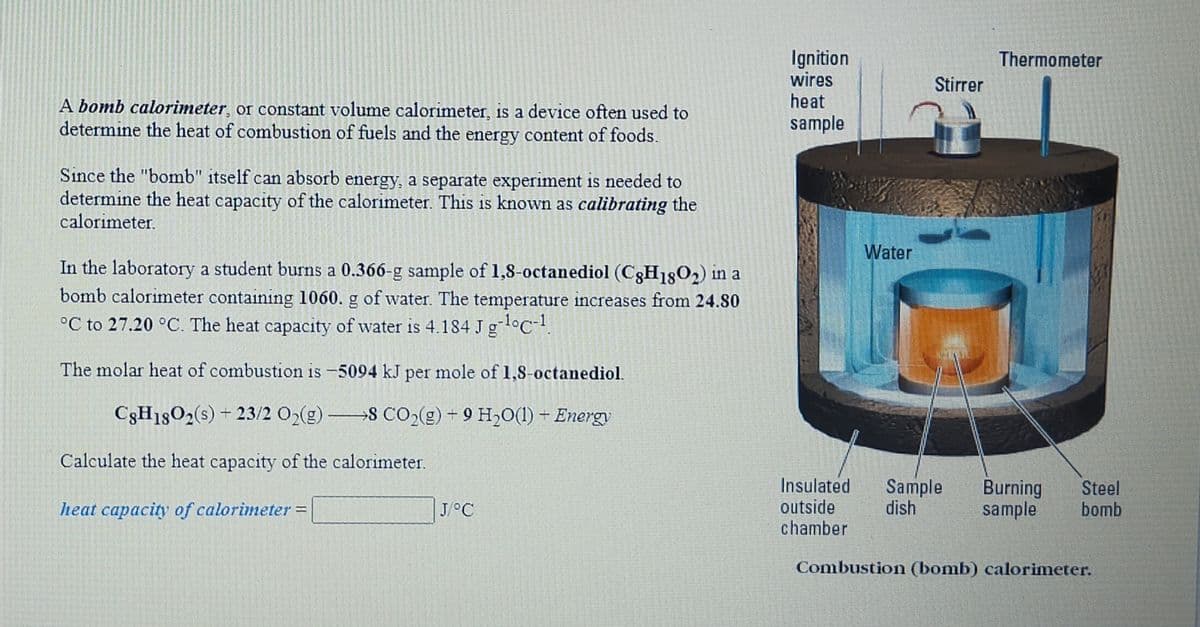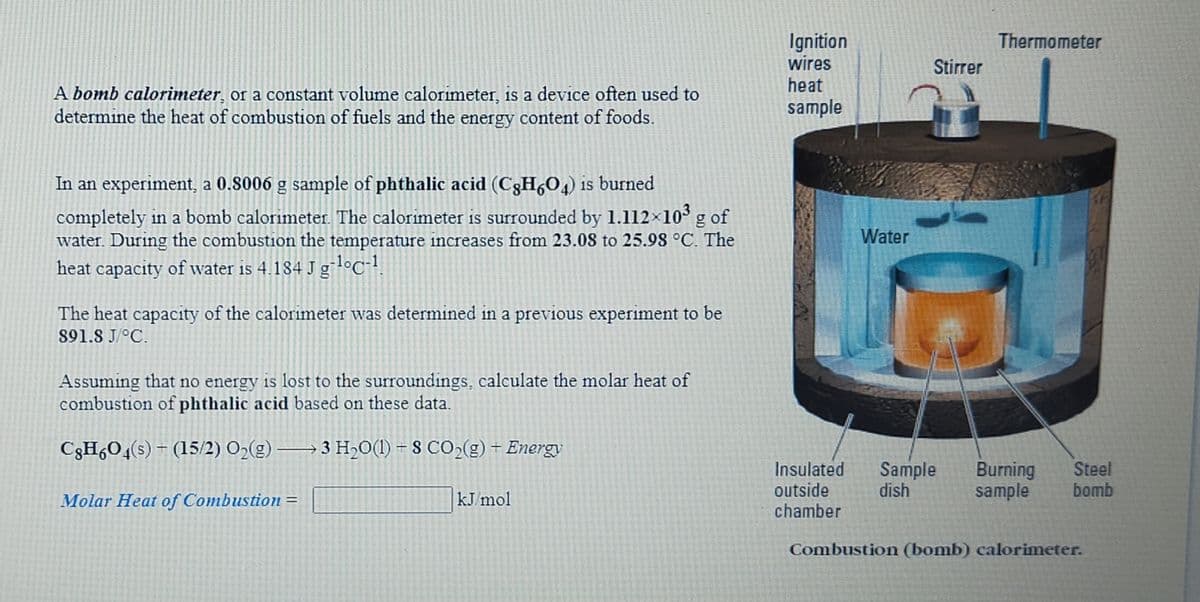In the laboratory a student burns a 0.366-g sample of 1,8-octanediol (C3H18O2) in a bomb calorimeter containing 1060. g of water. The temperature increases from 24.80 °C to 27.20 °C. The heat capacity of water is 4.184 J gloC The molar heat of combustion is -5094 kJ per mole of 1,8-octanediol. C3H1802(s) + 23/2 02(g) 8 C02(g) - 9 H,0(1) + Energy Calculate the heat capacity of the calorimeter.
In the laboratory a student burns a 0.366-g sample of 1,8-octanediol (C3H18O2) in a bomb calorimeter containing 1060. g of water. The temperature increases from 24.80 °C to 27.20 °C. The heat capacity of water is 4.184 J gloC The molar heat of combustion is -5094 kJ per mole of 1,8-octanediol. C3H1802(s) + 23/2 02(g) 8 C02(g) - 9 H,0(1) + Energy Calculate the heat capacity of the calorimeter.
Introduction to Chemical Engineering Thermodynamics
8th Edition
ISBN:9781259696527
Author:J.M. Smith Termodinamica en ingenieria quimica, Hendrick C Van Ness, Michael Abbott, Mark Swihart
Publisher:J.M. Smith Termodinamica en ingenieria quimica, Hendrick C Van Ness, Michael Abbott, Mark Swihart
Chapter1: Introduction
Section: Chapter Questions
Problem 1.1P
Related questions
Question

Transcribed Image Text:Ignition
wires
heat
Thermometer
Stirrer
A bomb calorimeter, or constant volume calorimeter, is a device often used to
determine the heat of combustion of fuels and the energy content of foods.
sample
Since the "bomb" itself can absorb energy, a separate experiment is needed to
determine the heat capacity of the calorimeter. This is known as calibrating the
calorimeter.
Water
In the laboratory a student burns a 0.366-g sample of 1,8-octanediol (C3H18O2) in a
bomb calorimeter containing 1060. g of water. The temperature increases from 24.80
°C to 27.20 °C. The heat capacity of water is 4.184 J gloC-!
The molar heat of combustion is -5094 kJ per mole of 1,8-octanediol.
C3H18O2(s) + 23/2 O2(g) 8 CO2(g) + 9 H,0(1) + Energy
Calculate the heat capacity of the calorimeter.
Insulated
outside
chamber
Sample
dish
Burning
sample
Steel
bomb
heat capacity of calorimeter =
J/°C
Combustion (bomb) calorimeter.

Transcribed Image Text:Ignition
wires
heat
Thermometer
Stirrer
A bomb calorimeter, or a constant volume calorimeter, is a device often used to
determine the heat of combustion of fuels and the energy content of foods.
sample
In an experiment, a 0.8006 g sample of phthalic acid (C3H,04) is burned
completely in a bomb calorimeter. The calorimeter is surrounded by 1.112×10° g of
water. During the combustion the temperature increases from 23.08 to 25.98 °C. The
heat capacity of water is 4.184 J gl°C•!
Water
The heat capacity of the calorimeter was determined in a previous experiment to be
891.8 J/°C.
Assuming that no energy is lost to the surroundings, calculate the molar heat of
combustion of phthalic acid based on these data.
C3H,O4(s) – (15/2) O2(g) →3 H2O(1) = 8 CO>(g) + Energy
Insulated
outside
chamber
Sample
dish
Burning
sample
Steel
bomb
Molar Heat of Combustion =
kJ/mol
Combustion (bomb) calorimeter.
Expert Solution
This question has been solved!
Explore an expertly crafted, step-by-step solution for a thorough understanding of key concepts.
This is a popular solution!
Trending now
This is a popular solution!
Step by step
Solved in 4 steps with 3 images

Knowledge Booster
Learn more about
Need a deep-dive on the concept behind this application? Look no further. Learn more about this topic, chemical-engineering and related others by exploring similar questions and additional content below.Recommended textbooks for you

Introduction to Chemical Engineering Thermodynami…
Chemical Engineering
ISBN:
9781259696527
Author:
J.M. Smith Termodinamica en ingenieria quimica, Hendrick C Van Ness, Michael Abbott, Mark Swihart
Publisher:
McGraw-Hill Education

Elementary Principles of Chemical Processes, Bind…
Chemical Engineering
ISBN:
9781118431221
Author:
Richard M. Felder, Ronald W. Rousseau, Lisa G. Bullard
Publisher:
WILEY

Elements of Chemical Reaction Engineering (5th Ed…
Chemical Engineering
ISBN:
9780133887518
Author:
H. Scott Fogler
Publisher:
Prentice Hall

Introduction to Chemical Engineering Thermodynami…
Chemical Engineering
ISBN:
9781259696527
Author:
J.M. Smith Termodinamica en ingenieria quimica, Hendrick C Van Ness, Michael Abbott, Mark Swihart
Publisher:
McGraw-Hill Education

Elementary Principles of Chemical Processes, Bind…
Chemical Engineering
ISBN:
9781118431221
Author:
Richard M. Felder, Ronald W. Rousseau, Lisa G. Bullard
Publisher:
WILEY

Elements of Chemical Reaction Engineering (5th Ed…
Chemical Engineering
ISBN:
9780133887518
Author:
H. Scott Fogler
Publisher:
Prentice Hall


Industrial Plastics: Theory and Applications
Chemical Engineering
ISBN:
9781285061238
Author:
Lokensgard, Erik
Publisher:
Delmar Cengage Learning

Unit Operations of Chemical Engineering
Chemical Engineering
ISBN:
9780072848236
Author:
Warren McCabe, Julian C. Smith, Peter Harriott
Publisher:
McGraw-Hill Companies, The